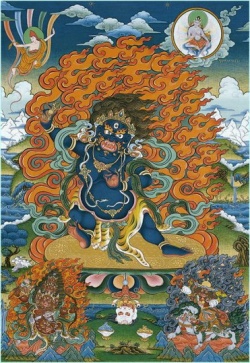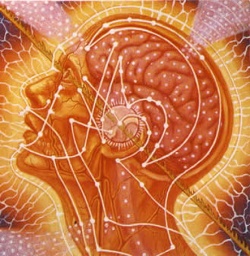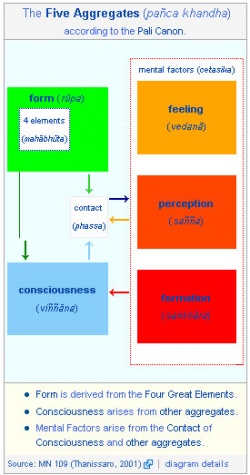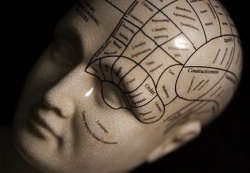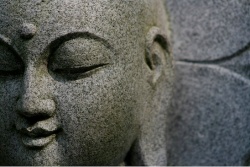Skandha
- See also:Khandha
In Buddhist phenomenology and soteriology, the Skandhas (Sanskrit) or Khandhas (Pāli, aggregates in English) are the five functions or aspects that constitute the human being. The Buddha teaches that nothing among them is really "I" or "mine".
In the Theravada tradition, Suffering arises when one identifies with or clings to an aggregate. Suffering is extinguished by relinquishing attachments to aggregates.
The Mahayana tradition further puts forth that ultimate freedom is realized by deeply penetrating the nature of all aggregates as intrinsically empty of independent existence.
Etymology
Outside of Buddhist didactic contexts, "skandha" can mean mass, heap, pile, bundle or tree trunk.
According to Thanissaro, The Buddha gave a new meaning to the term "khanda":
- Prior to The Buddha, the Pali word khandha had very ordinary meanings: A khandha could be a pile, a bundle, a heap, a mass. It could also be the trunk of a tree. In his first sermon, though, The Buddha gave it a new, psychological meaning, introducing the term clinging-Khandhas to summarize his analysis of the truth of stress and Suffering. Throughout the remainder of his teaching career, he referred to these psychological Khandhas time and again.
Description in the Sutta Pitaka
The Sutta Pitaka of the Pali Canon contains the teachings of The Buddha, as preserved by the Theravada tradition.
The Five Skandhas
The sutras describe five aggregates:
- "form" or "matter" (Skt., Pāli Rūpa; Tib. gzugs): external and internal matter. Externally, rupa is the physical world. Internally, rupa includes the material body and the physical sense organs.
- "sensation" or "feeling" (Skt., Pāli vedanā; Tib. tshor-ba): sensing an object as either pleasant or unpleasant or neutral.
- "perception", "conception", "apperception", "cognition", or "discrimination" (Skt. samjñā, Pāli saññā, Tib. 'du-shes): registers whether an object is recognized or not (for instance, the sound of a bell or the shape of a tree).
- "mental formations", "impulses", "volition", or "compositional factors" (Skt. samskāra, Pāli Saṅkhāra, Tib. 'du-byed): all types of mental habits, thoughts, ideas, opinions, prejudices, compulsions, and decisions triggered by an object.
- "consciousness" or "discernment" (Skt. Vijñāna, Pāli Viññāṇa, Tib. rnam-par-shes-pa):
- In the Nikayas/Āgamas: cognizance, that which discerns
- In the Abhidhamma: a series of rapidly changing interconnected discrete acts of cognizance.
- In some Mahayana sources: the base that supports all experience.
The Buddhist literature describes the aggregates as arising in a linear or progressive fashion, from form to feeling to perception to mental formations to consciousness. In the early texts, the scheme of the five aggregates is not meant to be an exhaustive classification of the human being. Rather it describes various aspects of the way an individual manifests.
Suffering and release
Bhikkhu Bodhi (2000b, p. 840) states that an examination of the aggregates has a "critical role" in The Buddha's teaching for several reasons, including:
- Understanding Suffering: the five aggregates are the "ultimate referent" in The Buddha's elaboration on Dukkha (Suffering) in his First Noble Truth: "Since all four truths revolve around Suffering, understanding the aggregates is essential for understanding the Four Noble Truths as a whole."
- Clinging causes; future Suffering: the five aggregates are the substrata for clinging and thus "contribute to the causal origination of future Suffering".
- Release from Samsara: clinging to the five aggregates must be removed in order to achieve release from Samsara.
Understanding Dukkha
In the Dhammacakkappavattana Sutta The Buddha provides the classic elaboration on the first of his Four Noble Truths, "The Truth of Suffering" (Dukkhasacca):
- The Noble Truth of Suffering dukkha), monks, is this: Birth is Suffering, aging is Suffering, sickness is Suffering, death is Suffering, association with the unpleasant is Suffering, dissociation from the pleasant is Suffering, not to receive what one desires is Suffering—in brief the five aggregates subject to grasping are Suffering.
Clinging causes Future Suffering
The Samyutta Nikaya contains the Khandhavagga ("The Book of Aggregates"), a book compiling over a hundred suttas related to the five aggregates.
The Upadaparitassana Sutta ("[[Agitation through Clinging Discourse}}," SN 22:7) describes how non-clinging to form prevents agitation:
- ...he instructed noble disciple ... does not regard form [or other aggregates) as self, or self as possessing form, or form as in self, or self as in form.
That form of his changes and alters.
the change and alteration of form, his consciousness does not become preoccupied with the change of form.... hrough non-clinging he does not become agitated." (Trans. by Bodhi, 2000b, pp. 865-866.)
The most explicit denial of substantiality in the early texts is one that was quoted by later prominent Mahayana thinkers:
- All form is comparable to foam; all feelings to bubbles; all sensations are mirage-like; dispositions are like the plantain trunk; consciousness is but an illusion: so did The Buddha illustrate [the nature of the aggregates).
Release from Samsara
In the Pāli Canon and the Āgamas, the majority of discourses focusing on the five aggregates discusses them as a basis for understanding and achieving liberation from Suffering.
Liberation is possible by insight into the workings of the mind.
Traditional Mindfulness practices can awaken this by understanding, release and Wisdom.
In the classic Theravada meditation reference, the "Satipaṭṭhāna Sutta" ("The Foundations of Mindfulness Discourse," MN 10),
The Buddha provides four bases for establishing Mindfulness:
sensations (Vedana),
When discussing mental objects as a basis for meditation, The Buddha identifies five objects, including the aggregates.
Through Mindfulness contemplation, one sees an "aggregate as an aggregate" — sees it arising and dissipating.
Such clear seeing creates a space between the aggregate and clinging, a space that will prevent or enervate the arising and propagation of clinging, thereby diminishing future Suffering. As clinging disappears, so too notions of a separate "self."
No essence
The aggregates don't constitute any 'essence'.
In the Samyutta Nikaya, The Buddha explains this by using the simile of a chariot:
- A 'chariot' exists on the basis of the aggregation of parts, even so the concept of 'being' exists when the five aggregates are available.
Just as the concept of "chariot" is a reification, so too is the concept of "being".
The constituents of being too are unsubstantial in that they are causally produced, just like the chariot as a whole.
The chariot metaphor is not an exercise in ontology, but rather a caution against ontological theorizing and conceptual realism.
Part of The Buddha's general approach to language was to point towards its conventional nature, and to undermine the misleading character of nouns as substance-words.
Arahants
The skandha analysis of the early texts is not applicable to Arahants.
A Tathāgata has abandoned that clinging to the personality factors that render the mind a bounded, measurable entity, and is instead "freed from being reckoned by" all or any of them, even in life.
The Skandhas have been seen to be a burden, and an enlightened individual is one with "burden dropped".
Understanding in Theravada Abhidhamma
While early Buddhism reflects the teachings as found in the Pali Sutta Pitaka and the Chinese Agama, the Early Buddhist schools developed detailed analyses and overviews of the teachings found in those sutras, called Abhidharma.
Each school developed its own Abhidharma. the best known is the Theravāda Abhidhamma.
The Sarvāstivāda Abhidharma has been preserved partly in the Chinese Agama.
Six consciousnesses
- See also:Ayatana and Ṣaḍāyatana
The teaching of the six sense bases provides an alternative to the five aggregates as an description of the workings of the mind.
In this teaching, the coming together of an object and a sense-organ results in the arising of the corresponding consciousness.
The suttas themselves don't describe this alternative.
It is in the Abhidhamma, striving to "a single all-inclusive system" that the five aggregates and the six sense bases are explicitly connected.
This might be described as follows (illustrated in the figure to the right):
- Form (Rūpa) arises from experientially irreducible physical/physiological phenomena.
- The coming together of an external object (such as a sound) and its associated internal sense organ (such as the ear) — gives rise to consciousness (Viññāṇa • vijñāṇa).
- The concurrence of an object, its sense organ and the related consciousness (Viññāṇa • vijñāṇa) is called "contact" (Phassa • Sparśa).
- From the contact of form and consciousness arise the three mental aggregates;
saṃjñā) and
mental formation (Saṅkhāra • Saṃskāra).
- The mental aggregates can then in turn give rise to additional consciousness that leads to the arising of additional mental aggregates.
In this scheme, form, the mental aggregates, and consciousness are mutually dependent.
Twelve Sense Bases
There are Twelve Sense Bases:
- The first five external sense bases (visible form, sound, smell, taste and touch are part of the form aggregate.
- The mental sense object (that is, [[mental objects}}) overlap the first four aggregates (form, feeling, perception and formation).
- The first five internal sense bases (eye, ear, nose, tongue and body) are also part of the form aggregate.
- The mental sense organ (mind) is comparable to the aggregate of consciousness.
While the benefit of meditating on the aggregates is overcoming wrong views of the self (since the self is typically identified with one or more of the aggregates),
the benefit of meditation on the six sense bases is to overcome craving (through restraint and insight into sense objects that lead to contact, feeling and subsequent craving).
Eighteen Dhātus
The eighteen dhātus – the Six External Bases, the Six Internal Bases, and the Six Consciousnesses – function through the five aggregates.
The eighteen dhātus can be arranged into six triads, where each triad is composed of a sense object, a sense organ, and sense consciousness.
In regards to the aggregates:
- The sixth sense organ (mind) is part of consciousness.
- The first five sense objects (visible forms, sound, smell, taste, touch) are also derivatives of form.
- The sixth sense object (mental object) includes form, feeling, perception and mental formations.
- The six sense consciousness are the basis for consciousness.
| Six External Bases (bāhya-āyatana) | Six Internal Bases (adhyātma-āyatana) | Six Consciousnesses (Vijñāna) |
|---|---|---|
| (1) Visual Objects (Rūpa-āyatana) | (2) Eye Faculty (cakṣur-indriya-āyatana) | (3) Visual Consciousness (cakṣur-Vijñāna |
| (4) Auditory Objects (çabda-āyatana) | (5) Ear Faculty (śrota-indriya-āyatana) | (6) Aural Consciousness (śrota-Vijñāna) |
| (7) {Olfactory Objects (gandha-āyatana) | (8) Nose Faculty (ghrāṇa-indriya-āyatana) | (9) Olfactory Consciousness (ghrāṇa-Vijñāna) |
| (10) Gustatory Objects (rasa-āyatana) | (11) Tongue Faculty (jihvā-indriya-āyatana) | (12) Gustatory Consciousness (jihvā-Vijñāna) |
| (13) Tactile Objects (spraṣṭavya-āyatana) | (14) Body Faculty (kaya-indriya-āyatana) | (15) Touch Consciousness (kaya-Vijñāna) |
| (16) Mental bjects (Dharma-āyatana) | (17) Mental Faculty (mano-indriya-āyatana) | (18) Mental Consciousness (mano-Vijñāna) |
Four Paramatthas
The Abhidhamma and post-canonical Pali texts create a meta-scheme for the Sutta Pitaka's conceptions of aggregates, sense bases and dhattus (elements).
This meta-scheme is known as the four paramatthas or four ultimate realities.
Ultimate realities
There are four paramathas;
three conditioned,
one unconditioned:
- Mental factors (the nama-factors sensation, perception and formation)
Mapping of the paramathas
The mapping between the aggregates, the twelve sense bases, and the ultimate realities is represented in this chart:
| aggregate | external Sense base | internal Sense base | ultimate reality |
| form | visible form, sound, smell, taste, touch | eye, ear, nose, tongue, body | 28 material phenomena |
| mental objects (Dhamma) |
|||
| sensation | 52 mental factors |
||
| perception | |||
| formation | |||
| conscious- ness (Vinnana) | mind (mana) | conscious- ness (Citta) |
|
| Nibbāna |
Twelve Nidanas
- See also:Dependent origination
The Twelve Nidanas describe twelve phenomenal links by which Suffering is perpetuated between and within lives.
Inclusion of the five aggregates
Embedded within this model, four of the five aggregates are explicitly mentioned in the following sequence:
- which conditions name-and-form (nāma-Rūpa)
- which conditions the precursors (Saḷāyatana, Phassa • Sparśa) to sensations (vedanā)
- which ultimately lead to the "entire mass of Suffering" (kevalassa dukkhakkhandha).
The interplay between the five-aggregates model of immediate causation and the twelve-Nidana model of requisite conditioning is evident, for instance underlining the seminal role that mental formations have in both the origination and cessation of Suffering.
Three lives
According to Schumann the Nidanas are a later synthesis of Buddhist teachings, meant to make them more comprehensible.
Comparison with the five skhandhas shows that the chain contains logical inconsistencies, which can be explained when the chain is considered to be a later elaboration.
This way it is explainable that nama-rupa en consciousness in the 9-fold are the beginning or start, while in the 12-fold chain they are preced by ignorance and formations.
Those can only exist when nama-rupa en consciousness are present.
Schumann also propeses that the 12-fold is extended over three existences, and illustrate the succession of rebirths.
while Buddhaghosa en Vasubandhu maintain a 2-8-2 schema, Schumann maintains a 3-6-3 scheme, putting the Five Skandhas aside the Twelve Nidanas.
| Schumann | |
|---|---|
| The 12-fold chain | the 5 skhandhas |
| First existence | |
| 1. Body | |
| 2. Sensation | |
| 3. Perception | |
| 1. Ignorance | |
| 2. Formations | 4. Formations |
| 3. Consciousness | 5. Consciousness |
| Second existence | |
| 4. Nama-rupa | 1. Body |
| 5. The six senses | |
| 6. Touch | |
| 7. Sensation | 2. Sensation |
| 3. Perception | |
| 4. Formations | |
| 5. Consciousness | |
| 8. Craving | |
| 9. Clinging | |
| Third existence | |
| 10. Becoming | |
| 1. Body | |
| 11. Birth | |
| 2. Sensation | |
| 3. Perception | |
| 4. Formations | |
| 5. Consciousness | |
| 12. Old age and death | |
Understanding in the Mahayana-tradition
The Mahayana developed out of the traditional schools, introducing new texts and putting other emphasises in the teachings, especially Sunyata and the Bodhisattva-ideal.
India
Prajnaparamita
The Prajnaparamita-teachings developed from the first century BCE onward.
It emphasises the "emptiness" of everything that exists.
This means that there are no eternally existing "essences", since everything is dependently originated.
Skandhas too are dependently originated, and lack any substantial existence .
This is famously stated in The Heart Sutra.
The Sanskrit version of the classic "Prajnaparamita Hridaya Sutra" ("Heart Sutra") states:
The noble Avalokiteshvara Bodhisattva,
while practicing the deep practice of Prajnaparamita
looked upon the Five Skandhas,
seeing they were empty of Svabhava (self-existence) when "emptiness of self)]" is mentioned, the English word "self" is a translation of the Pali word "Atta" (Sanskrit, "Atman"); in the Sanskrit-version of The Heart Sutra,
In the second verse, after rising from his aggregate meditation, Avalokiteshvara declares:
Form is emptiness, emptiness is form,
form does not differ from emptiness, emptiness does not differ from form.
The same is true with feelings, perceptions, mental formations and consciousness.
Madhyamaka
- See also:Madhyamaka
The Madhyaka-school elaborates on the notion of the Middle Way. Its basic text is the Mūlamadhyamakakārikā, written by Nagarjuna.
Nagarjuna refuted the Sarvastivada conception of reality, which reifies dhammas.
The simultaneous non-reification of the self and reification of the Skandhas has been viewed by some Buddhist thinkers as highly problematic.
Yogacara
- See also:Yogacara
The Yogacara-school further analysed the workings of the mind, and developed the notion of the Eight Consciousnesses.
These are an elaboration of the concept of nama-rupa and the Five Skandhas, adding detailed analyses of the workings of the mind.
China
When Buddhism was introduced in China it was understood in terms of its own culture. Various sects struggled to attain an understanding of the Indian texts.
The Tathāgatagarbha Sutras and the idea of the Buddha-nature were endorsed, because of the perceived similarities with the Tao, which was understood as a transcendental reality underlying the world of appearances.
Sunyata at first was understood as pointing to the Taoist "wu", nothingness.
Absolute and relative
In China, the relation between absolute and relative was a central topic in understanding the Buddhist teachings.
The aggregates convey the relative (or conventional) experience of the world by an individual, although Absolute truth is realized through them.
Commenting on The Heart Sutra, D.T. Suzuki notes:
- When the Sutra says that the Five Skandhas have the character of emptiness [...], the sense is: no limiting qualities are to be attributed to the Absolute; while it is immanent in all concrete and particular objects, it is not in itself definable.
Tathagatagarbha
- See also:Tathagatagarbha
The Tathāgatagarbha Sutras, which developed in India, played a prominent role in China.
The Tathagatagarbha-sutras, on occasion, speak of the ineffable Skandhas of The Buddha (beyond the nature of worldly Skandhas and beyond worldly understanding).
In the Mahayana Mahaparinirvana Sutra The Buddha tells of how The Buddha's Skandhas are in fact eternal and unchanging.
The Buddha's Skandhas are said to be incomprehensible to unawakened vision.
Tibet
The Vajrayana tradition further develops the aggregates in terms of mahamudra epistemology and tantric reifications.
Insubstantiality
Referring to mahamudra teachings, Chogyam Trungpa identifies the form aggregate as the "solidification" of ignorance (Pali, Avijja; Skt., Avidya),
allowing one to have the illusion of "possessing" ever dynamic and spacious Wisdom (Pali, vijja; Skt. vidya), and thus being the basis for the creation of a dualistic relationship between "self" and "other."
According to Trungpa Rinpoche, the Five Skandhas are "a set of Buddhist concepts which describe experience as a five-step process" and that "the whole development of the Five Skandhas...is an attempt on our part to shield ourselves from the truth of our insubstantiality," while "the practice of meditation is to see the transparency of this shield."
Deity yoga)]===
Trungpa Rinpoche writes (2001, p. 38):
- ome of the details of tantric iconography are developed from Abhidharma [that is, in this context, detailed analysis of the aggregates). Different colors and feelings of this particular consciousness, that particular emotion,
are manifested in a particular deity wearing such-and-such a costume, of certain particular colors, holding certain particular sceptres in his hand. Those details are very closely connected with the individualities of particular psychological processes.
Bardo deity manifestations
The Tibetan Book of the Dead (Fremantle & Trungpa, 2003) makes the following associations between the aggregates and tantric deities during the Bardo after death:
- The blue light of the skandha of consciousness in its basic purity, the Wisdom of the dharmadhātu, luminous, clear, sharp and brilliant, will come towards you from the heart of Vairocana and his consort, and pierce you so that your eyes cannot bear it. [p. 63]
- The white light of the skandha of form in its basic purity, the mirror-like Wisdom, dazzling white, luminous and clear, will come towards you from the heart of Vajrasattva and his consort and pierce you so that your eyes cannot bear to look at it. [p. 66]
- The yellow light of the skandha of feeling in its basic purity, the Wisdom of equality, brilliant yellow, adorned with discs of light, luminous and clear, unbearable to the eyes, will come towards you from the heart of Ratnasambhava and his consort and pierce your heart so that your eyes cannot bear to look at it. [p. 68]
- The red light of the skandha of perception in its basic purity, the Wisdom of discrimination, brilliant red, adorned with discs of light, luminous and clear, sharp and bright, will come from the heart of Amitābha and his consort and pierce your heart so that your eyes cannot bear to look at it. Do not be afraid of it. [p. 70]
- The green light of the skandha of concept (samskara) in its basic purity, the action-accomplishing Wisdom, brilliant green, luminous and clear, sharp and terrifying, adorned with discs of light, will come from the heart of Amoghasiddhi and his consort and pierce your heart so that your eyes cannot bear to look at it.
Do not be afraid of it. It is the spontaneous play of your own mind, so rest in the supreme state free from activity and care, in which there is no near or far, love or hate. [p. 73]

